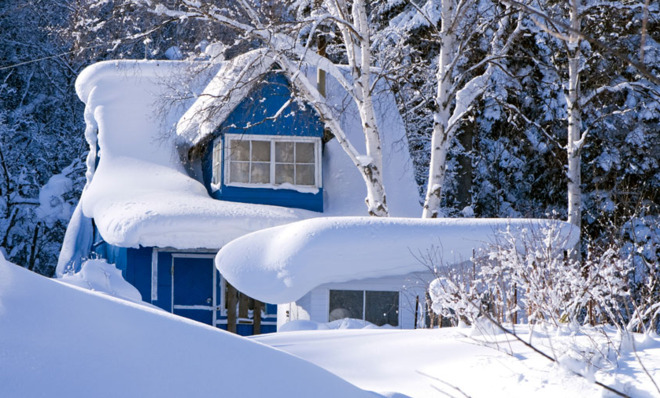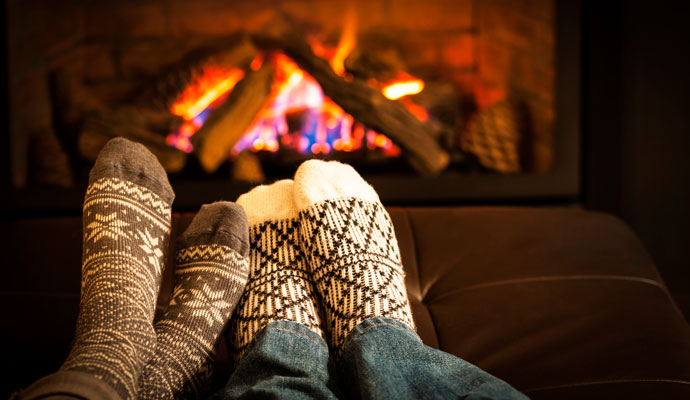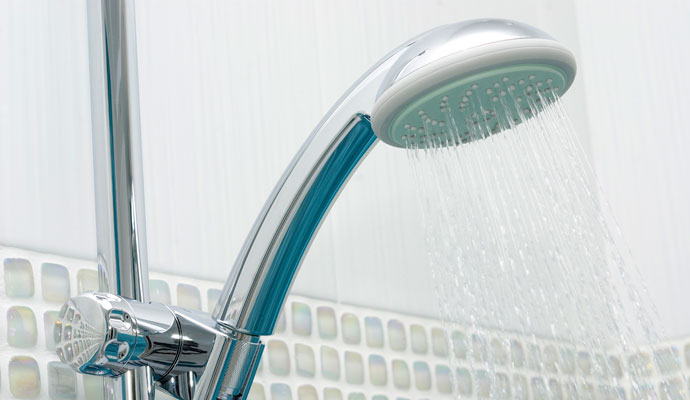How to slash your winter bill, according to utilities experts
You can start by using that traditional fireplace sparingly


Sunday afternoon football. The smell of pumpkin pie wafting through the house. Stringing up holiday lights.
Now that the leaves have started to change and crisp nights have set in, there are all sorts of seasonal highlights to look forward to — but are you also envisioning the extra cash you'll be shelling out to keep those lights twinkling and the heat cranked up?
Of course you're not.
The Week
Escape your echo chamber. Get the facts behind the news, plus analysis from multiple perspectives.

Sign up for The Week's Free Newsletters
From our morning news briefing to a weekly Good News Newsletter, get the best of The Week delivered directly to your inbox.
From our morning news briefing to a weekly Good News Newsletter, get the best of The Week delivered directly to your inbox.
That's because, while we're well aware of the conventional advice for cutting high monthly expenses — ditch the costly cable and pick up Netflix! — we rarely focus on the other sundry utility bills that fill our mailbox each month.
You know, the boring ones — like gas, electric, water and heat.
But those utilities can quickly add up to hundreds of dollars a month in the winter, which is why we rounded up utility employees across the country to share their top energy-saving tips for slashing those costs.
After all, how would you rather spend your fun money this season — on astronomical gas and heating bills or a weekend ski trip?
A free daily email with the biggest news stories of the day – and the best features from TheWeek.com
The heating expert: John Vrabel, president of Smart Click Energy, an online heating oil delivery company based in Boston

If you live in a colder state, I probably don't need to remind you that heating bills can spike into the triple digits.
In fact, the U.S. Energy Information Administration finds that more than 90 percent of American homes will get hit with even higher heating expenses this season, thanks to rising natural gas, propane and electricity prices.
Since heating costs can fall under your electric, gas or oil bill, seasonal totals vary greatly — from around $679 for natural gas to $2,046 if you use oil. But making a few smart moves before the mercury falls can result in lower bills later on, no matter your heating method.
My favorite money-saving hacks Right now — before a chill really sets in — call your utility company and schedule a tune-up to ensure your heating system will operate at peak efficiency. While a technician might cost you around $100, plus any necessary repairs, I can't emphasize enough that efficient equipment is key. By comparison, faulty heating systems could be costing you hundreds of dollars.
Next, take the time to inspect the insulation around your house. In a typical home, air leaks are responsible for a whopping 25 percent to 40 percent of the energy that's used for heating. But weather-stripping your windows can be done for as little as $6 per window.
Few people know about this, but one of my favorite techniques is to use an energy-efficient humidifier (about $35 to $65) in the living room. In winter months, the air inside your home is pretty dry. To be comfortable in dry air, people require a higher temperature — but they wouldn't if the air were more humid.
There are also simple cost-saving tweaks that seem obvious, but most people still overlook. For example, if you have a programmable thermostat, make sure warm-air registers aren't blocked by furniture or drapes, making it harder for those registers to gauge a true temp. Speaking of...if you live in a sunny area, keep curtains and shades up during the day to let sunshine naturally warm your home.
Lastly, I know everyone loves a nice, toasty fire during the winter, but try to use a traditional fireplace sparingly. It may look cozy, but these hearths actually pull heated air up the chimney — and let cold in. At the very least, keep the flue shut tight when you're not using it.
How much you'll save I'd estimate that these simple insulation changes can shave 10 percent off your home heating bill at a minimum — which could equal $200 or more per season, depending on the size of your house and your heating method.
The electricity expert: Emily Bailard, senior director of solutions at Opower, a company that helps utilities reduce consumption across the globe
Hacking your electric bill probably isn't the first thing that comes to mind when you think of fun fall activities. In fact, studies have shown that Americans only think about their electricity for nine minutes a year — and that's typically only when they receive a high bill or have an outage.
But U.S. Energy Information Administration data shows that, on average, most people are shelling out about $100 a month — and even more during the winter when we spend extra hours huddled indoors, burning lights longer. So if we all devoted just a few more minutes to focusing on dialing back electricity usage, it's remarkable how much money we could save.
My favorite money-saving hacks If you haven't already invested in LED holiday lights, now's the time. Not only will they reduce your electric use by more than 90 percent, compared to traditional incandescent bulbs, but they'll also last longer — upwards of 25,000 hours.
While you're at it, swap out all of your lightbulbs with energy-efficient ones; the upfront expense is minimal (starting at $9 a bulb), and will pay off big in the long run
Holiday shopping, ordering seasonal cards and sending out e-vites for wintertime gatherings — they've all become much easier to do thanks to computers. But that extra time online can really creep up your electric bill.
Rule of thumb: If you're not going to use your PC for more than 20 minutes, turn off your monitor. You might even consider unplugging it from a power source, since all electronics that remain plugged in still consume electricity — a waste of about 50 watts per device, or about $50 each per year.
That might not sound like much, but multiply $50 by the myriad electronics you keep running at any given time — TVs, phone chargers, computers — and you can see how quickly that cash adds up.
People don't often factor it in, but this time of year also leads to extended use of big appliances. More out-of-town guests and entertaining translates to extra sheets and towels to wash and dry, not to mention running the dishwasher constantly.
When it comes to your washing machine, I recommend following detergent instructions to a tee. Most people are too generous with the amount they use — and over-sudsing requires your machine to run energy-zapping extra rinses. Further, use the cold water setting on your washer whenever you can. Surprisingly, it reduces energy use by as much as 94 percent.
How much you'll save You know those LED bulbs you just bought to replace your old ones? It takes about $9 a year to run one through the night, compared to $21 for a conventional bulb. That's savings of more than 50 percent right there!
Also, keep in mind that excessive electric use tends to be billed at a higher rate, with your base rate jumping to a higher bracket after a certain amount is used. Translation: The more electricity you save, the more drastic your money savings.
The water expert: Lyle Whitney, water conservation supervisor at the Aurora Water Department in Aurora, Colorado

"I find it amazing how much water we use when we're not thinking about it — and how much savings that can translate to if we are a little more conscious.
The average home uses about 150 gallons of water per capita, per day, which is what we call 'GPCD.' In Colorado, a full 42 percent of that goes toward outside usage, like lawn sprinklers. So the good news is that a fair amount of consumption will creepdown in the winter.
But indoor use can easily be scaled back, too, with just a few simple behavior changes and appliance swaps.
My favorite money-saving hacks Let's start with the biggest water guzzler in the house: your toilet, which takes up 25 percent of GPCD. In other words, this is a key area to consider investing in a more efficient appliance.
If you have an older toilet, you're likely using as much as 3.5 gallons of water per flush — but newer ones flush 1.5 or less, and cost as little as $75. And before you buy, check with your water utility company because many provide rebates for installing more efficient toilets.
Next up: those long, hot showers we indulge in once the weather turns crisp.
In most households, the average shower clocks in at close to nine minutes. Of course, trimming that to five minutes can help a great deal.
But there's also a lasting fix: While most shower heads release 2.5 gallons of water per minute, energy-efficient models release closer to one gallon per minute. They cost about $20, and most people don't even notice the reduction in water pressure — but they offer serious savings over the long haul.
Besides water-smart upgrades to your appliances, I swear by small habit changes. For example, making a household rule to only run the washing machine when it's full, rather than doing that half load of table linens before a holiday party, can save up to 49 gallons of water per wash. Ditto when it comes to the dishwasher.
How much you'll save If you tackle the small appliance tweaks above, you can typically scale back usage from 150 to 100 GPCD — and save at least $100 a year.
But I assure you it's very doable to shave off even more. I average about 40 to 50 gallons a day, thanks to simple habits like taking shorter showers."
The gas expert: Frank Benedetto, vice president of Van Duzer Gas in Southold, N.Y.
While many newer houses use electric heating units, a full 50 percent of all homes in the U.S. still use natural gas — a bill that often goes up tremendously during the winter months due to hot water, holiday cooking and heating systems.
But there are small ways to scale back on gas usage — and score pretty decent savings over the course of a season.
My favorite money-saving hacks I know this may sound funny, but if you have a gas stove, simply cleaning the burners and wiping away spider webs in the gas lines can greatly boost the efficiency of your cooking range. If you're uncomfortable doing it, you can have a full cleaning and inspection done by your utility for about $150 to $175.
Further, learning how to optimize your cooking range is really the simplest way to slash your bill.
For example, utilize the smaller burner if you're just simmering your food instead of bringing it to a boil. And grab the best-fitting pot for the amount you're cooking, as opposed to the first size you can find. Case in point: Placing a 6-inch pot on an 8-inch burner wastes more than 40 percent of the burner's heat.
I'd also recommend making use of the classic crockpot when cooking hearty autumnal dishes. This device consumes far less energy than the oven and burners.
How much you'll save Depending on your gas usage, I'd estimate that these simple moves can cut about 15 percent off your annual bill — that's nearly $300 in savings this season."
This story was originally published on LearnVest. LearnVest is a program for your money. Read their stories and use their tools at LearnVest.com.
More from LearnVest...

